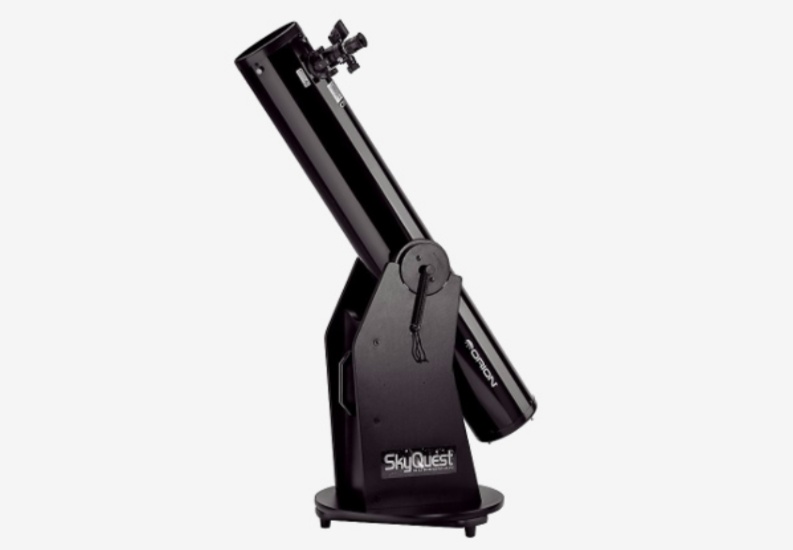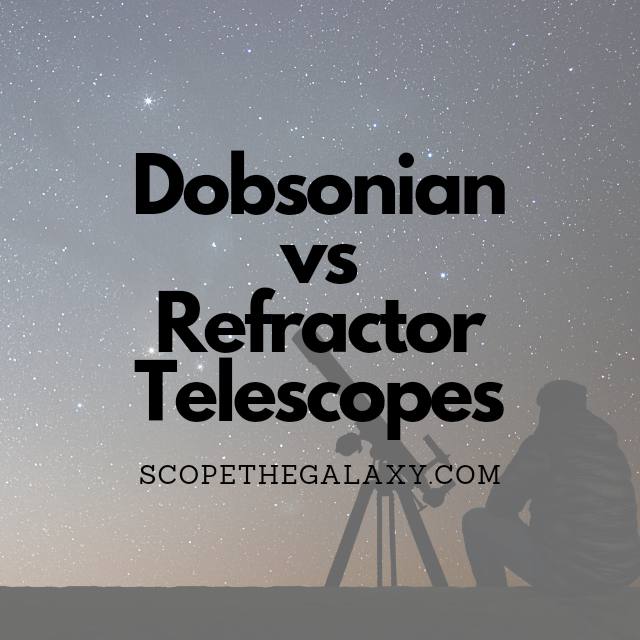*This post may contain affiliate links. This means we may make a commission if you purchase an item using one of our links*
The main differences between Dobsonian telescopes and refractor telescopes are that Dobsonian telescopes utilise mounts that only move up, down left and right at any given time while refractors can move in every direction depending on the mount used and premium refractive telescopes are often better than Dobsonian telescopes for astrophotography.
For a more detailed look at what makes Dobsonian and refractor telescopes similar, the strengths of each telescope type and the differences between the two, continue reading as it will be covered in more detail below.
What Is A Dobsonian Telescope?
Table of Contents

Dobsonian telescopes are reflective telescopes, meaning they rely entirely on mirrors to generate images. Dobsonian telescopes do contain a small focuser lens near the eyepiece, but this doesn’t really affect the quality of the image in the same way that a corrector lens in a compound based telescope would.
Dobsonian telescopes are pretty simple in terms of how they work. Light enters through the main aperture of the telescope and reflects off of a primary mirror at the telescope’s other end. This light then hits a secondary mirror which in turn sends it through the focuser lens and into the eyepiece.
There are a few additional characteristics of a Dobsonian telescope that set it apart from other reflective telescopes. The first is the fact that Dobsonian telescopes all use an alt azimuth mount, which allows the telescope to be moved on a vertical and horizontal axis simultaneously.
Dobsonian telescopes also tend to be pretty large on average, but they’re also relatively lightweight and cheap thanks to the materials they use. In particular, Dobsonian telescopes are often made with thinner mirrors than other reflective telescopes, and their main tubes are often made with materials like heavy-duty cardboard.
What Is A Refractor Telescope?

A refractor telescope is the oldest optical variation used within telescopes as it was made all the way back in 1733. Refractors can come in a few different variation from an achromatic doublet design to the far more expensive yet higher quality doublet and triplet apochromatic telescopes.
The achromatic optics are generally used within the more lower end telescope (for beginners) who mostly want to use their device for visual use and don’t really mind the visual imperfections that come with it such as chromatic aberration.
Apochromatic telescope however are reserved for individuals seeking a much higher end experience and those who may also be interested in the prospect of astrophotography.
The doublet and triplet variations have their differences (you can read this article for a more thorough breakdown) but as a whole, they’re far superior to achromatic devices as chromatic aberration and even spherical aberration is mostly fixed with these refractors.
For this extra quality you will need to pay a premium, which in most cases is several times more than an achromatic device. Furthermore, in a lot of instances you’d also need to purchase a mount whereas achromatic based devices tend to come fully prepped with all the relevant equipment at a much cheaper price.
How Are Dobsonian And Refractor Telescopes Similar?
Both dobsonian and refractor telescopes can be used to view celestial objects in space at a magnified rate based on their aperture size. They both use a mount although your typical dobsonian uses an alt azimuth mount and refractors use equatorial mounts.
Other than their basic practical uses, Dobsonian and Refractors do operate slightly different from one another.
Differences Between Dobsonian And Refractor Telescopes
As for the differences between the two, they would be as such:
- Dobsonian telescopes are telescopes that use a specialized mount whereas refractor telescopes describe the lens used within any give telescope.
- Dobsonion telescopes often use reflector optics within their chassis although refractor lenses can still be used.
- Refractor lenses can come in either achromatic or in the more expensive apochromatic format whereas Dobsonian telescopes often use spherical or Newtonian lenses.
- Refractor telescopes are made of a variety of materials from, plastic, metal, wood and so on while Dobsonian based telescopes are mostly made of wood.
- Refractor devices at higher aperture levels with the same aperture are better quality than Dobsonian telescopes as their contrast levels are superior whilst image quality won’t be quite as diluted due to the light reaching the eyepiece in a singular motion.
- Refractor telescopes are more expensive when considering the price to aperture ratio.
- Dobsonian telescopes can only move up, down, left and right whereas refractor telescopes can move in every direction based on the mount attached to the refractive system.
- Apochromatic based refractor telescopes are far better at astrophotography over Dobsonian telescopes.
- Dobsonian telescopes are far bulkier than refractor telescopes of the same aperture.
Summary
As a whole despite the fact both device types operate for the same purpose, which is to allow the every day person an opportunity to get a closer look at the celestial bodies that surround, they still do have their slight functional differences.
Dobsonian telescopes can only move up, down, left and right at one time while refractors can go in all directions, refractors are generally more expensive than a similar sized Dobsonian and refractors are better for astrophotography, especially when apochromatic lenses are used.

